Thursday 27 September 2012
Quokka - Marsupial Waste Recycler
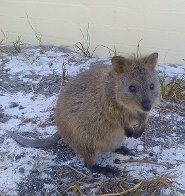
While European explorers have variously mistaken them for rats and
wild cats,
quokkas (
Setonix brachyurus) are actually small marsupials, morphologically similar to wallabies and, to a lesser extent, kangaroos but typically smaller. Quokkas can weigh up to 5 kilograms (about 11 lbs); growing to just 54cm (21.3 inches) tall and 30cm (11.8 inches) long.
Quokkas are adapted to the warm climate of Western Australia and the largest population of them is found on Rottnest Island near Perth. Indeed, the island, somewhat indirectly, is named for the presence of quokkas. In 1696, an early explorer of Western Australia (then New Holland), the Dutch sea captain - Willem de Vlamingh, considered the quokkas to be vermin and named the island 'Rottnest', which is Dutch for 'rat nest'. This less than flattering name has, it seems, stood the test of time.
Rottnest Island is something of a safe-haven for quokka, as it is free of fox and cats that were, in fact, only relatively recently introduced to the island by European settlers. Moreover, laws on the island mean that it is illegal for visitors to interfere with the animals in any way. However, the quokkas' complete lack of fear of humans, which means that they remain highly vulnerable to abuse.
There is a small mainland population of quokkas in Two Peoples Bay; however, here the predation threat is a lot higher, particularly from foxes and domestic cats. The animals, therefore, require dense vegetation for cover. On the mainland the quokka are sympatric with Gilbert's Potoroo, another marsupial, sometimes called a rat-kangaroo.
Quokkas are mainly nocturnal and exclusively herbivorous, feeding on grasses and leaves. However, they are thought to be able to survive for extended periods without any food or water. The Rottnest population is thought to have suffered a certain degree of ill health due to being fed inappropriate food-stuffs by tourists, including bread. Visitors to the island are, as outlined above, now requested not to feed or handle these animals.
Quokkas can breed at any point during the year, however, on Rottnest Island their breeding period is usually confined to late summer. Females produce just one joey per year with a gestation period of four months. The joey will reside in the mother's pouch for a further 25 weeks and will continue to be suckled by the mother for an additional ten weeks after that.
Perhaps the most fascinating (and disgusting) facts about the quokka is that they recycle a small amount of their own waste products. Such caecotrophy is common in the animal kingdom and is practiced by many other mammals, including rabbits. It allows for the re-processing of any material that has made its way through the entirety of the animal's digestive system without being fully digested. Such coprophagous behaviour can be expected to be most common during times of low food abundance or extremely high physiological demand (e.g. during pregnancy and/or lactation).
Picture of the Quokka on Rottnest Island WA Australia 2008, by Gavin Williams, licensed under
GFDL
You can help spreading the word about this animal by liking it on facebook
Permanent Link
Thursday 13 September 2012
The Extremely Social Black-Tailed Jackrabbit
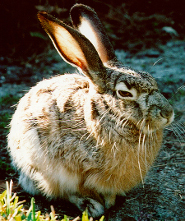
The
Black-Tailed Jackrabbit or Desert hare (Lepus Californicus) belongs to the common hare species and is found at elevations up to 10,000 feet from the sea level in Mexico and Western America.
The jackrabbit, like its other family members, has long ears, powerful and long rear legs, and a specific characteristic of rabbits. The average height of the hare is about 61cm (2 feet) and the weight of a mature hare is about 1.4-2.7 kg (3-6 pounds). Among all rabbit species found in North America, the black-tailed jackrabbit is the third largest rabbit. The dorsal fur of this rabbit is agouti in color and it is creamy white from undersides and the inner parts of the legs. The inside of the ears is unpigmented and the outer surface is black-tipped.
The black-tailed jackrabbit is a native of chaparral, prairie, and desert communities, and can be seen feeding itself in cultivated lawns and green pastures. Although by nature it is nocturnal and crepuscular, sometimes, it can be seen during the daytime as well. Its diet mainly includes sagebrush, cactus, grasses, juniper berries, alfalfa and clover type crop plants and mesquite. It fulfills its need of water from the food it eats, and so it drinks very little water. Unlike other family members of this species, the black-tailed jackrabbits do not live in burrows. During the daytime, they rest in shallow scrapes known as "Forms", or dig a hole in the soil and generally, under some vegetation cover.
In order to save itself from predators, this jackrabbit relies on its acute hearing power and speed. Its running speed can be as much as 64 to 72 km per hour (40 to 45 miles per hour) and it can leap as high as 19 feet in a single jump. Its natural enemies include ferruginous hawks, eagles, and red-tailed hawks. The mammalian carnivorous animals which are likely to pose a danger to its survival include foxes,
bobcats, and coyotes.
Although the black-tailed jackrabbit is a solitary animal, it often forages and rests in groups. Each individual of the group relies on other's ears and eyes to detect the predators.
Breeding among the species found in southern regions can occur throughout the year. In forests, females are capable of breeding before they reach one year of age, but it is found in very rare cases. A healthy female can give birth to four or five litters every year with one or eight young ones per litter. The weight of the wild leverets can be about 80 to 100 gm (2.8 to 3.5 oz) at birth but in captivity and when well-fed with good food, the weight of a young one can reach up to 155 gm. Gestation period of the jackrabbit is 45 days and although babies are precocial (independent and active from birth), the mother nurses her babies for full 12 weeks.
The population of black-tailed jackrabbit crashes due to some diseases (especially Tularemia). Moreover, environmental factors also have an effect on the population structure of any type of mammalians. Since black-tailed jackrabbits reproduce quite rapidly, the population covers the loss quickly after a crash in suitable conditions.
Picture of the black-tailed jackrabbit by Dana Krempels, licensed under
GFDL
You can help spreading the word about this animal by liking it on facebook
Permanent Link
Tuesday 11 September 2012
The Bar-tailed Godwit - Winged Marathoners
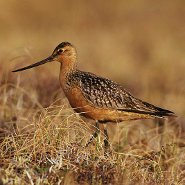
The
bar-tailed godwit (
limosa lapponica) is a wading bird with a long bill and long legs. It gets its name from the striped ("barred") markings on its tail feathers, which distinguishes the bird in appearance from the black-tailed godwit and other relatives.
The size of the bar-tailed godwit differs by sub-species, but on average, the birds are between 35-40 cm (13-16 inches) from bill to tale, with an average wingspan of around 75 cm (30 inches). The male of the species is smaller, weighing, on average, around 300g (just over 10.5 ounces). The female averages 370 grams, or around 13 ounces. The weights of both sexes, however, varies widely, depending on the time of year and geographic location.
While the bar-tailed godwit is found on all continents, primarily along the coasts, it is known to breed in parts of Asia and Alaska. The birds generally live in coastal habitats, such as marshes, sand flats, mudflats, estuaries, and inlets. When breeding, however, they prefer areas of lowland rolling tundra. Bar-tailed godwits feed primarily on insects, mollusks, and crustaceans.
Above all, bar-tailed godwits are known for their exceptional migratory patterns. These birds fly the length of the Pacific semi-annually. In early spring, they depart from Australia or New Zealand, heading directly to East Asia, where they stop to fatten up for a few weeks. Then, the birds fly the remainder to Alaska without pause. Each winter, the bar-tailed godwits return, flying the 6,800+ miles down the Pacific nonstop, making theirs the longest known non-stop migration flight.
To date, zoologists are uncertain why the bar-tailed godwit takes this route rather than a more friendly flight pattern over Asia, which would allow the birds to feed with regularity. Over time, however, the birds have evolved in order to be able to fly these incredible distances without stopping for food. They have small stomachs, which have been replaced by muscle and fat that is burned during flight.
At the present time, the conservation status of the bar-tailed godwit is unclear. The International Union for Conservation of Nature and Natural Resources rates the species as being of "lowest concern." The U.S. Shorebird Conservation Plan, however, has categorized the bird as a "Species of High Concern," in part, perhaps, based on the limited breeding grounds for them in the United States. While most of the threat to the bar-tailed godwit population comes from loss of habitat and expansion of industry, they also face encounters with predatory birds such as ravens and gulls.
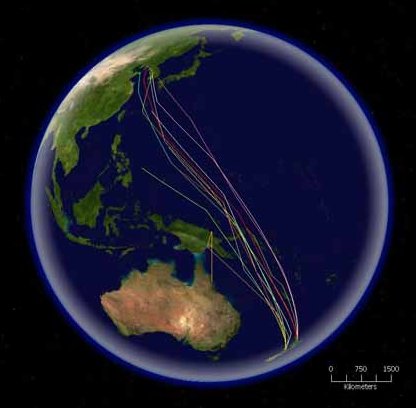
The routes of satellite tagged Bar-tailed Godwits migrating north from New Zealand
Bar-tailed Godwits undertake the longest non-stop flight of any bird.
You can help spreading the word about this animal by liking it on facebook
Permanent Link
Monday 03 September 2012
The Ringed Seal, the Arctic's Earless Loner
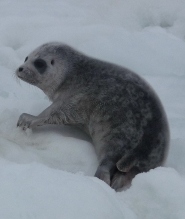
The
ringed seal (
Phoca hispida) is the most common seal in the Arctic. It is also the smallest seal in the Arctic and is also known as the jar seal. The Inuit call the ringed seal 'nattiq' or 'netsik'.
The ringed seal has a plump body with a short snout and a small head and what makes this animal unique is that it is an earless seal. Their belly has silver fur, but the rest of their coat is dark and covered on the back and sides with silver rings, which is how these seals got their name. They have small front flippers and claws that are more than 2.5 cm (1 inch) in thickness. They use their claws to make holes to breathe through the ice. These breathing holes are made through ice as thick as 2m (6.5 ft.). Their weight ranges from 45-72kg (100-160 lbs) and grows to an average length of 1.5m (5 ft.).
Ringed seals live throughout the Northern Hemisphere. The majority of ringed seals live in the Arctic Ocean, but we also find them in the Hudson Bay, the Baltic Sea, and the Bering Sea. They can be found from North America to Eurasia, and as far south as Japan, inhabiting the Seas of Okhotsk. One subspecies of the ringed seal is found in freshwater environments. The diet of the ringed seal is wide and varied. It eats small prey such as herring, shrimp, arctic cod and whitefish. It may also eat crustaceans such as perch and sculpin. They feed for polar cod along the edges of the sea ice in summer and their lifespan is 25 to 30 years. They do not like to gather in groups, and are solitary. When grouped together with other ringed seals they will separate themselves from others of their kind by long distances. When mating, the male will mate with more than one female.
Their natural predators include the
Arctic Fox,
polar bears,
wolverines,
wolves, and
orcas.
While ringed seals are an annual harvest of Arctic natives, they are not endangered at this time. However, they are protected, as are all marine mammals, under the Marine Mammal Protection Act (MMPA) of 1972. In addition, the Baltic ringed seal (Phoca hispida botnica) is listed by the International Union for the Conservation of Nature (IUCN) as vulnerable.
You can help spreading the word about this animal by liking it on facebook
Permanent Link
 While European explorers have variously mistaken them for rats and wild cats, quokkas (Setonix brachyurus) are actually small marsupials, morphologically similar to wallabies and, to a lesser extent, kangaroos but typically smaller. Quokkas can weigh up to 5 kilograms (about 11 lbs); growing to just 54cm (21.3 inches) tall and 30cm (11.8 inches) long.
While European explorers have variously mistaken them for rats and wild cats, quokkas (Setonix brachyurus) are actually small marsupials, morphologically similar to wallabies and, to a lesser extent, kangaroos but typically smaller. Quokkas can weigh up to 5 kilograms (about 11 lbs); growing to just 54cm (21.3 inches) tall and 30cm (11.8 inches) long.
 The
The  The
The 
 The
The